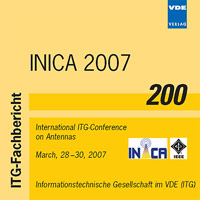Antenna Modeling with the Hybrid Finite Element Boundary Integral - Multilevel Fast Multipole - Uniform Geometrical Theory of Diffraction Method
Conference: INICA 2007 - International ITG-Conference on Antennas
03/28/2007 - 03/30/2007 at Munich, Germany
Proceedings: INICA 2007
Pages: 5Language: englishTyp: PDF
Personal VDE Members are entitled to a 10% discount on this title
Authors:
Tzoulis, A. (Institute of High Frequency Physics and Radar Techniques, FGAN e. V., 53343 Wachtberg, Germany)
Eibert, T. F. (Institute of Radio Frequency Technology, Universität Stuttgart, 70550 Stuttgart, Germany)
Abstract:
In many antenna applications, the environment of the radiating system has a significant effect on the overall radiation of the antenna and should be taken into account in the simulations. The involved objects are often electrically very large, so that numerical techniques combining ray optical asymptotic methods are preferred to handle such configurations. In this contribution, simulation results of electromagnetic radiation problems including environment effects are presented, using the recently developed hybrid method, which combines the Uniform Geometrical Theory of Diffraction (UTD) with the Finite Element Boundary Integral (FEBI) technique and with the Multilevel Fast Multipole Method (MLFMM). Electrically large and simple flat objects in the neighborhood of antennas are treated with UTD, providing full electromagnetic coupling with composite metallic/dielectric arbitrarily shaped FEBI objects. Thereby, double diffracted high-frequency fields on pairs of straight metallic non-coplanar and skewed edges are taken into account using the hard and soft scalar diffraction coefficients of UTD. Also, near-field computations in the postprocessing stage are efficiently accelerated by MLFMM, where ray optical contributions due to the presence of electrically large objects are taken into account according to the hybridization of MLFMM with UTD.


